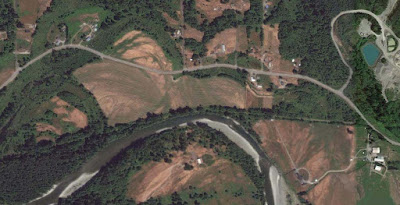I was invited to speak to the Lake Cavanaugh Improvement Association regarding their local geology. What follows is a slightly modified version of the talk from the presentation.
Bald Mountain (bald-mountain) is north of Lake Cavanaugh. It is well hidden from the low lands, but for anyone that ventures into the Lake Cavanaugh area it stands out as "What is that?" Dimensionally the block of greenschist is very close in size to Devils Tower. If this block of rock was located in a less mountainous location, it would likely be elevated to National Park or Monument status.
I set a few goals for the talk. The goal was to pass on a modest understanding of these three subjects:
So first up accretion terrains, a fundamental part of much of the geology of Washington State.
Jurassic age formation at Petrified Forest National Park. Nearly flat, extends for miles, not metamorphosed, and very well exposed.
Jurassic rocks in the Northwest Cascades. Mangled, in this case vertical bedding (actually not bedding - just looks like bedding), intensely metamorphosed, limited extent, and mostly covered with forest so exposures are piecemeal.
I used this image from Wikipedia that shows the formation of an accretionary prism/wedge.
Author: K.D. Schroeder
- graphic name.svg from Wikimedia Commons
- License: CC-BY-SA 3.0
- graphic name.svg from Wikimedia Commons
- License: CC-BY-SA 3.0
This map from the Geologic Map of Washington - Northwest Quadrant (WDGER Geologic Map GM-50) shows the various terrains that have been added onto northwest Washington State.
Lake Cavanaugh is located on the boundary between the Northwest Cascades System on the north (a group of terrains) and the Eastern and Western Melange belts to the south.
The specific terrain to the north is the Helena-Haystack Melange summarized as follows:
The setting of the Helena-Haystack Melange is indicated very roughly on the following image of the Jurassic world.
Colorado Plateau Geosystems, Inc. via Wikipedia
Bald Mountain is part of the Helena-Haystack Melange. It is a large block of greenschist (metamorhopsed basalt) that is erosion resistant relative to the softer metamorphosed mudstones that were formerly around it.
To the south side of Lake Cavanaugh is the Eastern Melange Belt:
Unfortunately these rocks are not particularly photogenic. Hence, I left off rock pictures for the most part. This is a picture of some of the metamorphosed volcanic rock of the Eastern Melange Bely on the steep slopes of Frailey Mountain above Lake Cavanaugh to the south of the lake.
The map below is from the Snoqualmie Pass 1:100,000 Quadrangle geologic map by Tabor and others.
Lake Cavanaugh is located along the Devils Mountain Fault. The fault is thought to be a major tectonic boundary between the Eastern and Western Melange Belts to the south and the Helana-Haystack Melange to the north. An interesting aspect of the fault is that it appears to be actually off set by the Straight Creek Fault. Note the HH Melange and NWCS south of Mount Stewart. The idea is that the Devils Mountain Fault was once part of the Olympic-Wallowa Lineament that was offset to the north by the Straight Creek Fault.
The Devils Mountain Fault is summarized:
I did have some bedrock formation rock pictures of the Bulson Creek conglomerate that crops out on the lower southwestern slopes of Frailey Mountain. The cobbles include rocks from the Eastern Melange Belt and the Helana-Haystack. The idea is that this formation formed within basins associated with movement along the Devils Mountain Fault.
Approximate maximum extent of continental glacial ice during the last ice age 18,000 years ago
Puget ice lobe blocking river outlets from the Cascades.
The dark blue represents potentially lake areas in Cascade valleys
Ice advancing into Lake Cavanaugh area water flow into the North Fork Stillaguamish glacial lake
LiDAR view of area north of Lake Cavanaugh showing the resistant Bald Mountain and the ice scour across the landscape.
I touched briefly on over consolidated lake sediments and how they loose stability over time.
Landslide failure surface within over consolidated silt/clay
Hard compact silt/clay
Same silt/clay showing partings opening up where water can flow through and further weaken the material























































